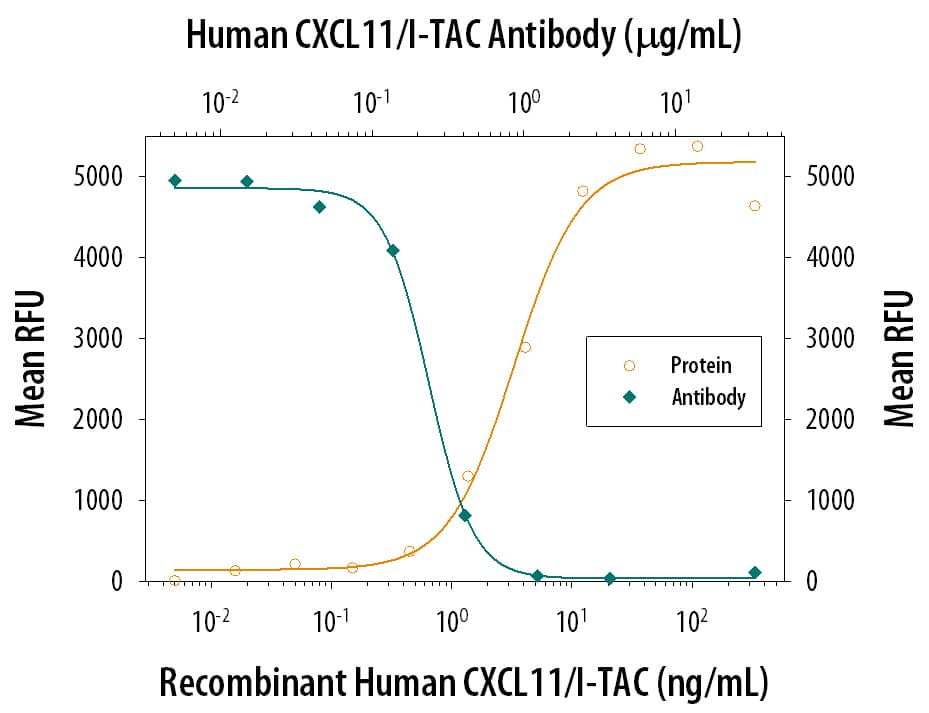Human CXCL11/I-TAC Antibody
R&D Systems, part of Bio-Techne | Catalog # MAB672

Key Product Details
Species Reactivity
Validated:
Cited:
Applications
Validated:
Cited:
Label
Antibody Source
Product Specifications
Immunogen
Phe22-Phe94
Accession # O14625
Specificity
Clonality
Host
Isotype
Endotoxin Level
Scientific Data Images for Human CXCL11/I-TAC Antibody
Chemotaxis Induced by CXCL11/I-TAC and Neutralization by Human CXCL11/I-TAC Antibody.
Recombinant Human CXCL11/I-TAC (672-IT) chemoattracts the BaF3 mouse pro-B cell line transfected with human CXCR3 in a dose-dependent manner (orange line). The amount of cells that migrated through to the lower chemotaxis chamber was measured by Resazurin (AR002). Chemotaxis elicited by Recombinant Human CXCL11/I-TAC (15 ng/mL) is neutralized (green line) by increasing concentrations of Human CXCL11/I-TAC Monoclonal Antibody (Catalog # MAB672). The ND50 is typically 0.0400-0.480 µg/mL.Applications for Human CXCL11/I-TAC Antibody
Western Blot
Sample: Recombinant Human CXCL11/I-TAC (Catalog # 672-IT)
Neutralization
Human CXCL11/I-TAC Sandwich Immunoassay
Formulation, Preparation, and Storage
Purification
Reconstitution
Formulation
*Small pack size (-SP) is supplied either lyophilized or as a 0.2 µm filtered solution in PBS.
Shipping
Stability & Storage
- 12 months from date of receipt, -20 to -70 °C as supplied.
- 1 month, 2 to 8 °C under sterile conditions after reconstitution.
- 6 months, -20 to -70 °C under sterile conditions after reconstitution.
Background: CXCL11/I-TAC
CXCL11, also known as I-TAC, SCYB9B, H174 and beta-R1, is a non-ELR CXC chemokine. CXCL11 cDNA encodes a 94 amino acid (aa) residue precursor protein with a 21 aa residue putative signal sequence, which is cleaved to form the mature 73 aa residue protein. CXCL11 shares 36% and 37% amino acid sequence homology with IP-10 and MIG (two other known human non-ELR CXC chemokines), respectively. CXCL11 is expressed at low levels in normal tissues including thymus, spleen, and pancreas. The expression of CXCL11 mRNA is radically up regulated in IFN-gamma and IL-1 stimulated astrocytes. Moderate increase in expression is also observed in stimulated monocytes. CXCL11 has potent chemoattractant activity for IL-2 activated T cells and transfected cell lines expressing CXCR3 but not freshly isolated T cells, neutrophils, or monocytes. The gene encoding CXCL11 has been mapped to chromosome 4.
References
- Cole, K. et al. (1998) J. Exp. Med. 187:2009.
- Sandhya Rani, M. et al. (1996) J. Biol. Chem. 271:22878.
- Lou, Y. et al. (1998) J. Neurovirol. 4:575.
Alternate Names
Gene Symbol
UniProt
Additional CXCL11/I-TAC Products
Product Documents for Human CXCL11/I-TAC Antibody
Product Specific Notices for Human CXCL11/I-TAC Antibody
For research use only
